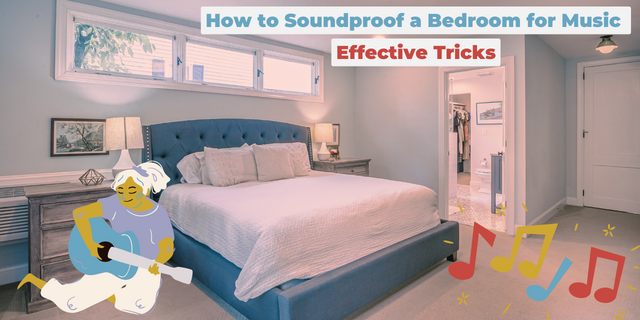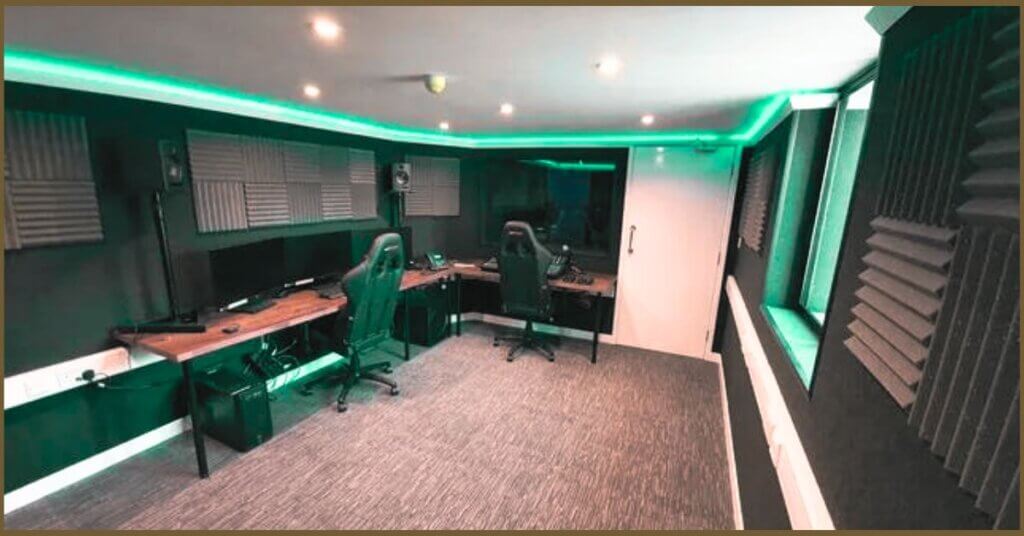If you are a music lover or musician then you might want to soundproof your bedroom for music. We’ll show you some easy and effective tips on how to soundproof a bedroom for music.
Soundproofing your bedroom can help you enjoy your music without disturbing others with outside noise. Soundproofing can also improve the sound quality of your music by reducing unwanted echoes and resonances.
How to Soundproof a Bedroom for Music: 4 Easy Ways
You can use four primary methods to soundproof your bedroom for music:
- Absorption
- Damping
- Decoupling
- Filling gaps

1. Absorption
Use acoustic panels
Acoustic panels are panels that are designed to absorb sound. You can purchase acoustic panels from a music store or online. You can also make your acoustic panels using materials like fiberglass mineral wool or foam.
You can hang acoustic panels on the walls and ceiling of your bedroom to reduce the amount of sound that reflects off the surfaces. Acoustic panels can also help control reverberations and echoes in your room which can improve the sound quality of your music
Read also: How To Soundproof A Bedroom From Outside Noise
Use soundproof curtains or thick blankets
You can also absorb some sound by hanging soundproof curtains or thick blankets on the walls and windows of your bedroom. Soundproof curtains are curtains that are made of heavy and dense fabric that can block and absorb sound. Thick blankets can also muffle some outside noise
Use bookcases
You can also make your walls thicker and more soundproof by placing bookcases against them. Bookcases can act as barriers that block some sound waves from passing through. They can also absorb some sound with their books and other items. [How to Soundproof a Bedroom For Music]
2. Damping
Use vibration insulation pads
Vibration insulation pads are pads that are used to reduce the vibration of an object or a structure. Vibration can cause noise by transferring energy to the surrounding air and creating sound waves.
You can use vibration insulation pads to mount items that could shake or vibrate such as speakers instruments or furniture. This can prevent them from creating annoying buzzing or rattling sounds that could ruin your music experience
Read also: How to Soundproof a Bedroom Wall from Noisy Neighbours
Use a damping compound
A damping compound is a substance that is used to dampen the vibration of a structure or a material. A damping compound can be applied between layers of drywall plywood or metal to create a sandwich-like structure that reduces the amount of vibrational energy that is transmitted through it.
This can lower the amount of noise that is emitted from the structure or material. You can use a damping compound to reinforce your walls, ceiling, floor, or door with an extra layer of material that can dampen some sound waves
3. Decoupling

Use resilient channels
Resilient channels are metal strips that are used to create a gap between two layers of material, such as drywall or plywood. Resilient channels can be attached to the studs or joists of your wall, ceiling, or floor, and then another layer of material can be attached to the resilient channels.
This creates a decoupled structure that reduces the amount of sound transmission between the two layers of material. Resilient channels can also help isolate vibrations from one layer to another, which can reduce noise as well. [How to Soundproof a Bedroom For Music]
Use isolation clips and hat channels
Isolation clips and hat channels are another way to create a decoupled structure for your wall ceiling or floor. Isolation clips are metal clips that are attached to the studs or joists of your wall ceiling or floor and then hat channels are metal strips that are attached to the isolation clips.
Hat channels have a U-shaped cross-section that allows another layer of material to be attached to them. This creates a gap between the two layers of material that reduces the amount of sound transmission between them.
Isolation clips and hat channels can also help isolate vibrations from one layer to another, which can reduce noise as well
Read also: 7 Best Soundproof Curtains for Doors
4. Filling gaps
Use acoustic caulk and weatherstripping
Acoustic caulk and weatherstripping are materials that are used to seal gaps and cracks in a structure or a material. Gaps and cracks can allow sound waves to easily pass through which can increase the amount of noise in your room.
You can use acoustic caulk and weatherstripping to seal gaps and cracks around your door window outlets switches vents pipes or any other openings in your wall ceiling or floor. This can prevent sound waves from leaking in or out of your room.
Use a door sweep
A door sweep is a rubber strip that is attached to the bottom of a door to block the gap between the door and the floor. A door sweep can prevent sound waves from entering or exiting your room through the gap under your door.
If the gap is too large to cover with a door sweep, you can also nail a strip of lumber to the bottom of the door first, and then attach the door sweep to the lumber
What is Soundproofing?
Soundproofing is the process of making a room resistant to the passage of sound waves. The purpose of soundproofing is to block external noises from entering the room and keep internal noises from escaping the room.
It’s difficult to block one hundred percent of sound waves from entering or escaping a room, but achieving a significant amount of noise reduction is feasible.
Soundproofing the room: why is it important?
Soundproofing a music room is essential to obtain quality sound when playing the guitar or another instrument. Indeed a poorly soundproofed studio can create sounds that are bad and even unpleasant to the ear, which can lead to a less satisfactory result.
Soundproofing a music room is therefore crucial to achieving the best possible sound, whether you are a professional sound engineer or a simple amateur. There are several ways to soundproof a room and several products that can help you achieve this goal.
Conclusion
How to Soundproof a Bedroom For Music can help you enjoy your music without disturbing others or being disturbed by outside noise. Soundproofing can also improve the sound quality of your music by reducing unwanted echoes and reverberations.
You can use various methods and materials to soundproof your bedroom for music, such as absorption, damping, decoupling, and filling gaps. You can also combine different methods and materials to achieve a higher level of soundproofing for your bedroom.
1 thought on “How to Soundproof a Bedroom For Music: 4 Ways”